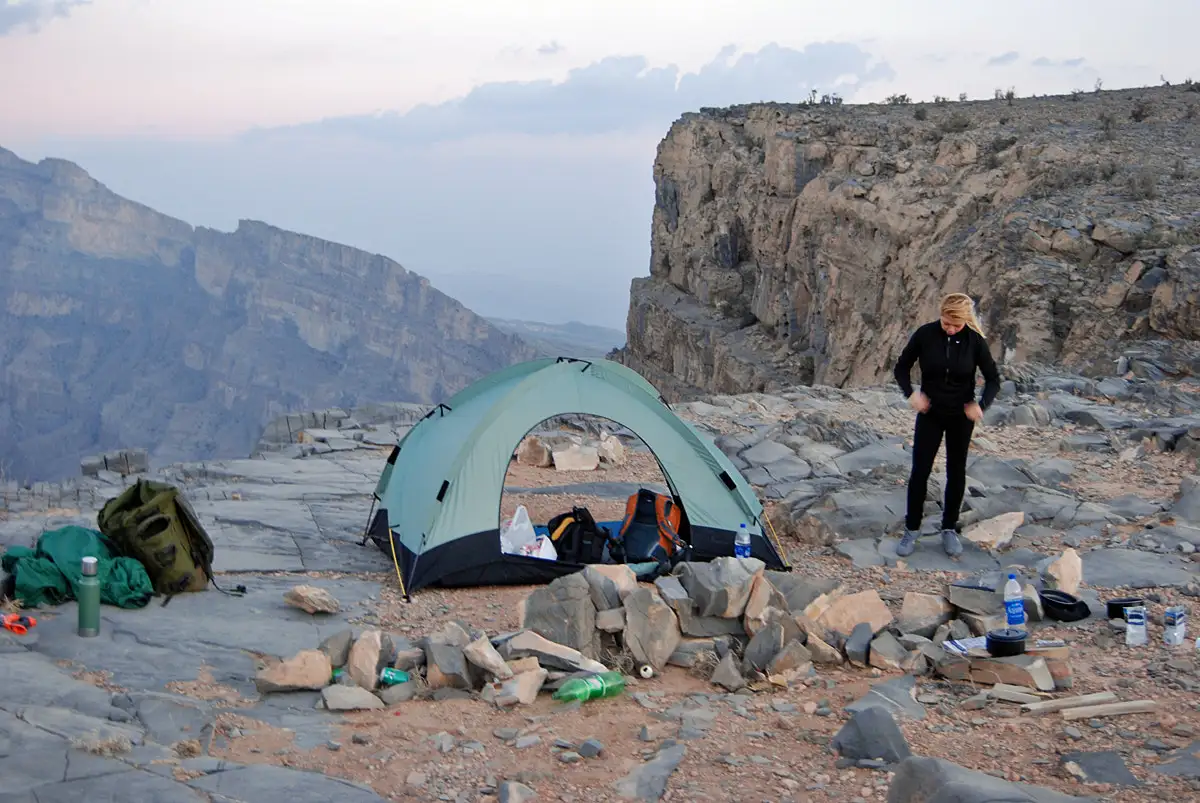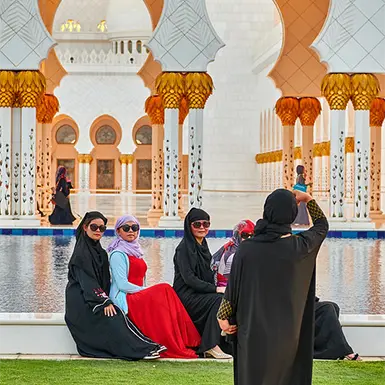The Al Hajar Mountains majestically stretch across northeastern Oman into the United Arab Emirates, defining the landscape of the Arabian Peninsula. These mountains, known for their rugged terrain and spectacular views, significantly shape the region’s geography and natural history. They reveal dramatic peaks and vast valleys, offering more than just visual splendor. These mountains serve as a critical site for geological research, providing insights into the movements of the earth’s crust and historical climate shifts.
This range acts as a geographical boundary and natural barrier, influencing the climate and biodiversity of adjacent regions. The Hajar Mountains’ diverse ecosystems attract geologists and ecologists eager to study its complex environment.
Jebel Shams: The Crown of the Al Hajar Mountains
- Height and Prominence: Rising to 3,028 meters, Jebel Shams is the tallest peak in the Al Hajar Mountains, commanding the surrounding landscape.
- Renowned Nickname: Often called the “Mountain of the Sun,” Jebel Shams is famous for its breathtaking sunrises and sunsets that light up the land below.
- Cultural and Historical Importance: Jebel Shams holds excellent cultural and historical value for local communities. It draws tourists and trekkers who wish to experience its unique high-altitude environment and the authentic Omani culture that the nearby villages preserve.

Climate Variability Across the Al Hajar Mountains
The Al Hajar Mountains experience a diverse climate that changes with altitude. Climbing the slopes, you move from the dry, desert conditions typical of the Arabian Peninsula to a cooler, more moderate climate.
- Shifts in Temperature: The temperatures at higher altitudes are markedly more extraordinary than the intense heat in the lower desert areas, offering relief during peak heat months.
- Biodiversity Impact: This variation in climate supports a unique mix of plants and animals adapted to thrive in the cooler, more moist conditions, creating a stark contrast with the dry surroundings.
Geological Significance of the Al Hajar Mountains
It is prominent in northeastern Oman, extends into the UAE, and is geologically significant. These mountains, formed over millions of years by the collision between the Arabian and Eurasian Plates, display a dramatic landscape with rugged terrain, towering peaks, and deep gorges. They provide a fascinating window into the Earth’s geological past, displaying rock layers that trace back hundreds of millions of years.
The undulating terrain of this mountain showcases sharply defined peaks, cliffs, and deep valleys, which are serious challenges that also present extraordinary beauty. The mountain range is a remarkable sight and an important field of study for researchers analyzing tectonic movements and the development of Earth’s crust in this particular area. Besides, these mountains are of geological importance because they contain some unusual rock shapes and abundant minerals.
Formation and Structure
- Tectonic Origins: This mountain arose from the collisions of the Arabian Plate with the Eurasian Plate over 70 million years ago.
- Challenging Landscape: The range, known for its steep ridges, deep canyons, and jagged peaks, presents a formidable terrain for both hikers and geologists.
- Distinctive Rock Layers: The mountains reveal diverse sedimentary and volcanic rock layers, providing critical insights into the geological history of the Earth’s crust.
Wadis and Caves
The Hajar Mountains host a variety of wadis and caves, adding to the region’s natural beauty and geological diversity. Wadi Ghul, often hailed as the “Grand Canyon of Oman,” stands out among these. This expansive canyon features soaring cliffs over 1,000 meters high and provides stunning panoramic views, making it a favorite among hikers and tourists. The profound gorges of Wadi Ghul highlight the enduring impact of erosion, which has sculpted the landscape over millennia.

Biodiversity of the Al Hajar Mountains
It spans northeastern Oman and the UAE and has dramatic geological features and extensive biodiversity. This region is a haven for many plant and animal life, establishing it as a crucial zone for ecological research and conservation activities.
Flourishing Plant Life
The vegetation in the Al Hajar Mountains is rich and well-suited to the challenging mountain conditions. Visitors and scientists will discover a variety of plants that thrive in the area’s dry climate.
- Diverse Vegetation: The higher reaches of this mountain boast wild olive trees and vast juniper forests. These plants are vital, providing shelter and sustenance to numerous mountain wildlife species.
- Healing Flora: The region also nurtures a wealth of medicinal plants, which local communities have utilized for generations. These plants, including herbs and shrubs, are fundamental to the region’s traditional medicinal practices.
The Dynamic Fauna
The wildlife in the Al Hajar Mountains is as diverse as the terrain itself, supporting a spectrum of species that maintain the area’s ecological balance.
- Mammalian Inhabitants: Notably, the Arabian tahr, indigenous to this area, is one of the most significant mammalian species here. Alongside it, mountain goats adeptly navigate the steep, rocky slopes.
- Avian Life: Bird lovers, rejoice! This Mountain is a birder’s paradise. You’ll be thrilled to spot Egyptian vultures gliding through the skies. These majestic birds are vital to the area’s ecosystem and attract nature enthusiasts worldwide.
Historical and Cultural Significance
It is located in northeastern Oman and extends into parts of the UAE, which are known for its breathtaking landscapes and rich historical and cultural heritage. This mountain range has been the cradle of human civilization for centuries, with ancient structures and traditional communities still thriving today.
Historical Sites
The Al Hajar Mountains are home to several historically significant sites that glimpse the region’s past. These sites, including ancient forts and settlements, reflect the area’s cultural and historical depth.
- Bahla Fort: Among the most notable landmarks on this Mountain is Bahla Fort, a UNESCO World Heritage Site. This ancient fort, with its towering walls and labyrinthine passages, dates back to the 13th century and served as a stronghold for the region. Bahla Fort is a testament to the strategic importance of this mountain throughout history.
- Misfat Al Abriyeen: Another historically significant site is the village of Misfat Al Abriyeen. This ancient village, nestled within this Mountains, showcases traditional Omani architecture with stone houses perched on the edge of steep terraces. The town offers visitors a unique perspective into the mountain communities that have thrived here for centuries.
Traditional Life
The Al Hajar Mountains indigenous people have long maintained a way of life deeply rooted in tradition. Despite modern advancements, these communities preserve their heritage through sustainable agricultural practices and cultural customs.
- Agricultural Terraces: Farming terraces is one of these Mountains’ most remarkable aspects of traditional life. These terraces, carved into the mountain slopes, are vital for growing crops like pomegranates, dates, and other fruits. The terracing conserves water and prevents soil erosion, making it an essential agricultural practice in the region.
- Falaj Irrigation Systems: The Falaj irrigation system is another critical feature of this mountain’s traditional life. This ancient method of water management, still in use today, channels water from mountain springs to irrigate farms and provide drinking water for local communities. The falaj system highlights the ingenuity of the mountain people in harnessing natural resources for sustainable living.
- Crop Production: These Mountains produce high-quality crops, including pomegranates, dates, and honey. These products drive the local economy, with honey highly prized for its purity and medicinal properties.

Outdoor Adventures
The Al Hajar Mountains, a stunning mountain range stretching across northeastern Oman into the UAE, offer many outdoor activities for adventure enthusiasts. From rugged hiking trails to thrilling climbing expeditions, these Mountains are a prime destination for those seeking to explore the great outdoors.
Hiking and Trekking
The Al Hajar Mountains are renowned for their breathtaking hiking routes and challenging trekking trails that cater to adventurers of all skill levels.
- Jebel Shams Balcony Walk: One of the most famous hiking paths is the Jebel Shams Balcony Walk, which offers panoramic views from high altitudes. Suitable for moderate to experienced hikers, this trail features stunning cliffside vistas and passes through historical ruins, providing a mix of natural beauty and cultural heritage.
- Oman Mountain Trail: To get the most out of your expedition, you can take the Oman Mountain Trail, which takes several days and runs across different terrains of this Mountain. This path has demanding routes for trekkers with several options in terms of difficulty level and the opportunity to enjoy beautiful sceneries and meet wild animals.
Climbing and Adventure Sports
As the rugged terrain of these Mountains becomes more popular, so do the adventure sports that the region supports. Rock climbing and canyoning are particularly popular here, offering adrenaline rushes and unique ways to experience the mountains’ natural beauty.
- Rock Climbing: These mountains boast numerous climbing sites with routes that range from beginner-friendly to expert-only. These areas are well-maintained by local climbing communities, ensuring safety without compromising the thrill of the climb.
- Canyoning: For those looking for an immersive adventure, canyoning in the gorges of these Mountains offers an exhilarating blend of swimming, climbing, and trekking.
Camping and Off-Roading
Camping and off-roading are excellent ways to experience the Al Hajar Mountains’ more remote and untouched landscapes.
- Camping Under the Stars: These Mountains’ clear skies and secluded nature make for ideal camping conditions. Several designated camping spots provide safe and scenic settings for an overnight stay under the stars.
- Off-Roading Adventures: Ultimate exploration is off-road driving in strange parts of this mountain, where adventurers would have nothing but the roughest places to go. But for dramatic trips like that, you must know what to bring along, be mindful of rules, and protect the environment first.
Exploring the Al Hajar Mountains: Tourism and Accessibility
The Al Hajar Mountains, straddling northeastern Oman and the UAE, perfectly blend natural beauty, historical richness, and adventure. This destination appeals broadly to those drawn to the outdoors, historical enthusiasts, and anyone. If you’re planning a visit, it’s crucial to understand the best routes, accommodation options, and the most favorable times to explore this majestic landscape.
Getting to the Al Hajar Mountains
The trip is quite direct, with the area being easily accessible from major cities such as Muscat and Nizwa.
- From Muscat: If you want to enjoy a scenic and flexible route, rent a car or hire a driver. By car, Muscat is only about two hours away from this Mountain.
- From Nizwa: Just an hour’s drive from the Mountains, Nizwa makes an excellent pit stop. It offers its historical attractions before continuing to the mountains.
- Via Private Tours: Although direct public transportation is lacking, numerous private tours and local guides are available, offering structured visits to the more remote parts of the mountains.
Accommodation Options
The Al Hajar Mountains host a variety of accommodations, from luxurious resorts to traditional guesthouses and outdoor camping sites.
- Luxury Resorts: The Alila Jabal Akhdar stands out for luxury seekers, providing opulent amenities with breathtaking mountain views. Similarly, the Anantara Al Jabal Al Akhdar Resort combines comfort with stunning scenery, ensuring a sumptuous stay.
- Traditional Guesthouses: Those looking for authenticity without breaking the bank might enjoy staying in conventional Omani guesthouses. These accommodations offer a deep dive into local culture and hospitality in mountain villages.
- Camping Opportunities: Various designated camping sites are available for visitors aiming to connect with nature. These sites are favorites among hikers and adventurers eager to experience the mountains under the stars.
Optimal Times to Visit
Choosing the right time to visit the Al Hajar Mountains can enhance your experience, particularly if you’re interested in outdoor activities.
- October to April: This period is the best time to visit, with cooler temperatures that are ideal for hiking, trekking, and general exploration. The crisp mountain air during these months offers a pleasant contrast to the hotter regions below.
- Summer Considerations: Although the higher altitudes provide some relief from the intense summer heat, the lower regions of these Mountains can still be quite warm, making vigorous outdoor activities more challenging.
Celebrating Culture in the Al Hajar Mountains: Festivals and Handicrafts
The Al Hajar Mountains, renowned for their rugged beauty and dramatic landscapes, also serve as a vibrant hub of cultural richness and traditional craftsmanship. Visitors to this majestic mountain range can engage with local culture by participating in various festivals and purchasing unique handicrafts. Here’s what you need to know about this Mountain’s cultural festivals and traditional crafts.
Local Festivals
The villages in the Al Hajar Mountains are bursting with cultural festivals that showcase Oman’s vibrant heritage. Join in the fun and experience the local traditions firsthand at these lively celebrations.
- Harvest Celebrations: In line with the agricultural lifestyle, many villages in these Mountains host harvest festivals, which mark the end of the growing season with feasting, dancing, and traditional music.
- Traditional Omani Festivals: Several traditional festivals occur throughout the year, during which villagers celebrate with folk dances, songs, and the preparation of unique dishes. These festivals are often tied to significant dates on the Islamic calendar, offering a glimpse into the residents’ spiritual and communal life.
Handicrafts and Souvenirs
The Al Hajar Mountains are also known for their artisanal crafts, which reflect the artistic heritage of the mountain communities. These handicrafts make excellent souvenirs and support the local economy.
- Pottery: In mountain towns, potters still work their magic, designing beautiful and valuable goods using ancient methods handed down over centuries. These include delicate ornamental articles as well as heavy everyday items.
- Weaving: Weaving is another traditional craft in the Mountains. Local weavers use natural fibers to produce textiles like rugs, shawls, and bags. These items often feature vibrant colors and patterns characteristic of Omani design.
- Silverwork: Oman highly prizes silverwork, and the Mountains are no exception. Artisans here craft exquisite jewelry, utensils, and decorative items using techniques honed over centuries.
Conservation and Environmental Stewardship
The Al Hajar Mountains, renowned for their stunning landscapes and rich biodiversity, are tackling various environmental challenges. These efforts aim to safeguard the region’s natural and cultural assets, ensuring its viability for future generations. Visitors can contribute to this unique area’s sustainability and responsible tourism by understanding and supporting these initiatives.
Active Preservation Efforts
Conservation initiatives are vigorously pursued in the Al Hajar Mountains to protect their unique environmental and cultural landmarks, crucial for maintaining ecological balance and historical continuity.
- Protected Areas: Establishing protected areas within these Mountains helps preserve diverse habitats and endemic species. This strategy is vital for maintaining ecological equilibrium and curbing habitat loss.
- Cultural Heritage Preservation: In these Mountains, a solid commitment persists towards conserving the cultural heritage of the locals. These efforts encompass the restoration of ancient forts and the preservation of traditional lifestyles central to their culture.
Tackling Environmental Challenges
The Al Hajar Mountains face environmental threats, compromising their ecological and cultural integrity. Addressing these issues is essential for the area’s long-term sustainability.
- Erosion Control: The inherent rugged terrain of the Al Hajar Mountains makes them susceptible to erosion, a situation worsened by human activities such as construction and unregulated trekking. Initiatives to control erosion include enforcing strict zoning laws and raising awareness among tourists and residents.
- Managing Over-Tourism: The popularity of the Al Hajar Mountains has led to over-tourism, which poses risks to their environmental health. Strategies to manage tourist numbers and promote sustainable tourism practices are crucial for mitigating these effects.
- Development Impacts: Development can improve local economies, but it often adversely affects the natural ecosystems. Strategic environmental assessments and community involvement in planning processes are crucial in ensuring sustainable and minimally disruptive development within the ecosystem.
Unique Attractions of the Al Hajar Mountains
The Al Hajar Mountains, a stunning mountain range in northeastern Oman, are home to various unique attractions that captivate travelers seeking natural beauty and cultural experiences. From the lush terraces of Jebel Akhdar to the hidden valleys of Dhofar, the Al Hajar Mountains provide plenty of opportunities to explore breathtaking landscapes and discover traditional Omani culture.
Jebel Akhdar: The Green Mountain
Jebel Akhdar, often called the “Green Mountain,” stands out in the Al Hajar Mountains for its unique landscape and agricultural richness. The cooler climate at its high altitude allows for various crops and plants to thrive, offering visitors a truly distinctive experience.
- Terraced Farms: One of the most astonishing parts of Jebel Akhdar is its terraced farms. Terraces line the sides of the mountains, where farmers grow various vegetable and fruit crops. Visitors can see some fresh fruits and vegetables produced from these farms; they give an impression of beauty in precision from far away.
- Rose Gardens: Another highlight of Jebel Akhdar is its famous rose gardens. These gardens bloom yearly, and workers harvest thousands of Damask roses to produce Omani rose water. This fragrant water, prized for its quality, is used in perfumes, beauty products, and traditional Omani cooking.
- Unique Produce: In addition to rose water, Jebel Akhdar is known for producing some of Oman’s finest pomegranates. The cooler temperatures and fertile soil of the Al Hajar Mountains create perfect conditions, making these fruits highly sought after both locally and internationally.
Dhofar and Hidden Valleys: Tranquil Escapes in the Al Hajar Mountains
For those seeking peace and solitude, the hidden valleys and lesser-known villages in the Dhofar region of the Al Hajar Mountains provide a serene escape from the more popular tourist destinations.
- Secluded Valleys: Several secret valleys in Dhofar are perfect spots for visitors to escape the noise urban centers create. They sit far from busy roads and are best suited for hiking, bird watching, or enjoying tranquil nature. These untouched natural spots allow one to connect intimately with nature.
- Traditional Villages: Scattered in the Al Hajar Mountains are small conventional villages that tourists hardly visit. The villages provide a sample of lives lived out for generations in a simple rural setup. Visitors can meet some of the local folks and learn their ways of life and customs.




